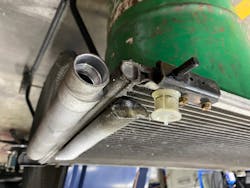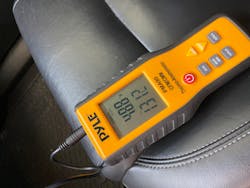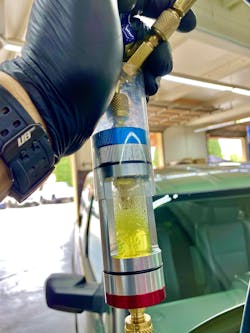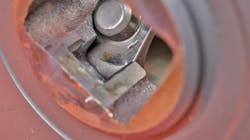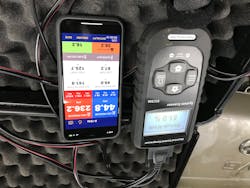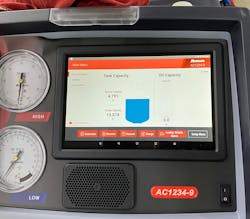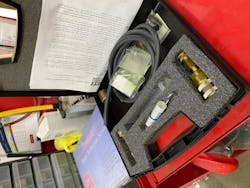However, there are other vehicle systems requiring support from the refrigeration system. For instance, vehicles equipped with electric drive systems may have components requiring thermal management. This may include battery packs, on-board chargers, and other power electronics. In this article, we’ll cover air conditioning system operation, diagnostics, and tooling. We’ll also tackle some of the challenges that DIY refrigeration recharge service kits can introduce.
Refrigeration basics
A refrigeration system’s primary goal is to move heat. This is primarily accomplished by pumping refrigerant carefully through a thermodynamic loop. The compressor provides the push-pull operation, and has energy costs to be considered. A great deal of R&D has resulted in significant compressor design changes.Modern compressors no longer featuring a compressor clutch will have an electronic variable output control system to regulate the compressor displacement. This can create diagnostic challenges for technicians. Later, we’ll cover the use of tools to help with diagnostics.
Refrigeration system service
I have seen some electrified vehicles call for desiccant replacement at specific intervals. HVAC systems have always included a receiver filter-drier component that contains desiccant, which is used to absorb moisture. Excess moisture will eventually lead to lower efficiency and compressor failures since it can negatively affect refrigerant oil’s lubrication properties. A good best practice is to replace the receiver drier whenever the system is opened.In regions that place high demand on the A/C system, frequent drier service may be recommended. For some vehicles, receiver drier service is straightforward. However, others will require condenser replacement if the receiver filter drier is integrated. In other cases, condenser removal may be required to access it. Figure 1 shows the desiccant bag and filter assembly removed from a vehicle with a serviceable filter.
Fig. 1 – Desiccant bag and filter
Inspections
One way you can help customers’ vehicles maintain healthy HVAC functionality is to implement inspection and maintenance programs. There are several tools on the market that can help you perform a professional inspection.Inspection Items
Cabin air filters
This filter can be easily overlooked, as they’re stored out of sight. Some vehicles may not even have one but can be upfitted. According to the Bosch Automotive Handbook, cabin air filters have a recommended replacement interval of every 12 months. Take a look at the owner’s manuals on vehicles you service for more info. Additionally, if you’re in an area where the vehicle may have been subjected to environmental conditions like forest fires, recommending cabin air filter service is a good practice. Additionally, filters may be checked for restriction using an anemometer as shown in figure 2.Fig. 2 - Pyle Thermo-Anemometer
Hoses and connections
You’ll want to inspect hoses and connections both for the presence of oil as a sign of leakage. Keep in mind that loose or broken engine mounts can lead to premature system leaks.Condensers
A/C condensers are frequently subject to small rocks and other debris. In some cases, there may be aftermarket screens that can be added to help prevent damage. When looking for leaks in the condenser area, it may be difficult to locate them until the system is fully charged and operating under normal pressures and temperatures.Evaporator
The evaporator can’t always be inspected easily, but the evaporator drain can help in terms of diagnostics. If this drain becomes restricted or plugged, mold, mildew, and corrosion of the evaporator can occur. You should also inspect the drain with a leak detector. In some cases, a borescope may be used to have a look if warranted. A system operating in warm temperatures and high humidity should produce a noticeable amount of condensate from the drain. In my shop, we use the MiST II Ultrasonic Cleaning unit from CPS Products to help eliminate mold and mildew smells within the vehicle’s cabin. This device does its job by introducing nano-droplets of cleaning solution throughout the HVAC air flow paths.Diagnostics
Scan tool
It’s always a good practice to perform a full vehicle scan when addressing system complaints. There may be other issues present that could prevent proper A/C system operation. Some vehicles may have an engine-related fault that could inhibit A/C compressor operation.Sight glass
Years ago, most vehicles possessed a sight glass to help the technician check system charge. Although you may come across some cars still using one, they can be used to check charge levels and whether the system contains fluorescent dye. However, there’s another type of sight glass that can help take a deeper look. Airsept offers a sight glass that can provide the technician with additional information. See figure 3. This tool can help assess the internals of the A/C system.When analyzing system performance, a check of the refrigeration oil condition can be very telling. We had a vehicle once where the variable displacement compressor wasn’t working properly and was barely able to produce pressure. The color of the oil was dark brown. Upon disassembly of the compressor, the swash plate pivoting mechanism was mechanically seized due to lack of lubrication. See figure 4.
Pressure and temperature
Pressure measurement is a great start to assessing system operation. Combining that data with temperatures is a gateway to gaining a deeper perspective into the system’s thermodynamic performance. The Man Tooth wireless pressure/temperature measurement kit from Yellow Jacket, along with your tablet or smartphone can help you quickly assess the A/C system’s performance. See figure 5.Variable displacement compressors - VDC
The ECCS06 by 4Seasons is a tool that we’ve been using in our shop to help us assess operation of the VDC’s. The device connects in series with the HVAC controller and the compressor. This tool allows you to monitor commands from the controller, and issue your own commands if needed. Couple this with the Man Tooth and you can make quick work of assessing compressor performance.Fig. 5 - Electronically Controlled Compressor Tester alongside the Man tooth
Leak detection
Refrigeration leaks can be challenging to identify. We’ve had cases where we were able to find a leak visually with the assistance of a black light and goggles only after the vehicle was fully charged and placed back into service for a short period of time. See figure 6.Fig. 6 – Condenser leak source revealed
Case study
A 2015 VW came in with a complaint that the A/C intermittently stopped cooling. After verifying the absence of fault codes, we performed a pressure and temperature checks using the Man Tooth and found that the system was working properly. After requesting more diagnostic time, we connected the VDC tester to monitor the control signal.We noticed right away that the tester display was intermittently flashing. I decided to connect the lab scope to observe the raw signal. A moderate tap to the HVAC control head resulted in the signal intermittently dropping out. (Figure 7) After securing authorization to remove the control head and check pin fitment, we condemned the control head.
Fig. 7 – Picoscope showing an intermittent drop out on the A/C control valve signal
Refrigerant handling
Most new vehicles are now equipped with R1234yf. If you’re wanting to service these vehicles, you’ll need the proper RRR machine along with a leak detector certified to the new SAE J2843 standard. (Figure 8) This new standard supports the new refrigerant requirements due to its flammability. During the recharge process, you’ll need to factor in about 20 minutes of additional time to complete the partial charge and evaporator leak test procedure. Right now, 1234yf is quite expensive, but you should expect the price to continue to drop as time goes on.Fig. 8 – R1234yf RRR Service Equipment
Challenges
The general public is able to purchase recharge kits that contain less than 2 lbs. A lot of these smaller DIY charge kits contain sealant, which can be detrimental to your service equipment. I know how painful it is to have a vehicle contaminate an expensive RRR machine with sealant. Here are a few ways to ensure that your A/C service equipment doesn’t get contaminated.1. While interviewing your customer, request HVAC system service history on their vehicle.
2. Look for the presence of sealant. The visual sight glass could be used, but it may not be as effective as the A/C Sealant Detection System Quick Detect tester by RTI Technologies (figure 9).
3. Add a special filter to your service equipment.
4. Keep in mind that the refrigerant identifier is unable to detect stop leak compounds.
Fig. 9 - RTI Quick Detect A/C Sealant Detection System
As you can see, vehicle technology continues to evolve, placing a greater demand on the service technician. Clearly, training and education is crucial in providing technicians with the information they need to stay on top of their trade.

